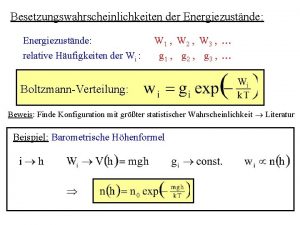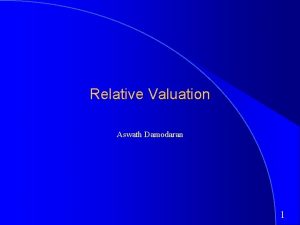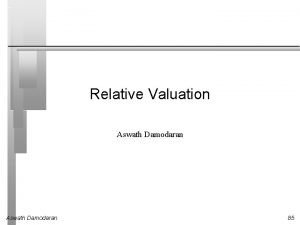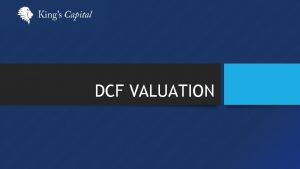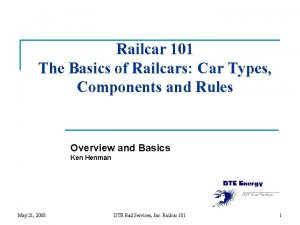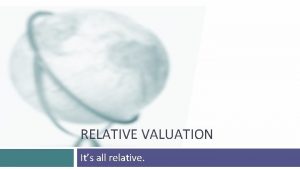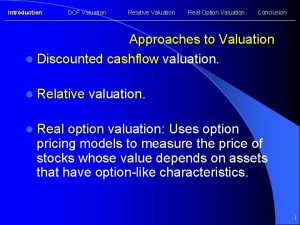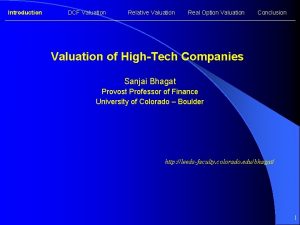RELATIVE VALUATION The Essence of relative valuation In












- Slides: 12

RELATIVE VALUATION

The Essence of relative valuation? In relative valuation, the value of an asset is estimated based on the values assessed by the market for similar or comparable assets. To do relative valuation then, �we need to identify comparable assets and obtain market values for these assets �convert these market values into standardized values, This process of standardizing creates price multiples. �compare the multiple for the asset being analyzed to the multiples for comparable asset, controlling for any differences between the firms that might affect the multiple, to judge whether the asset is under or over valued

Advantages � Relative valuation is much more likely to reflect market perceptions and moods than discounted cash flow valuation. � Relative valuation generally requires less information than discounted cash flow valuation => easier calculation.

Disadvantages � Relative valuation does not reflect the riskiness and the prospect of the company. � Relative valuation reflects the market moods => the result could be under valued or over valued. � Relative valuation is sensitive and more tailored to their needs.

Some popular multiples � Return multiple: P/E (Price to EPS) � Book value multiple: P/B � Revenue multiple: P/S � Specific multiples in particular industries. � ……….

Issues in relative valuation � Be careful when choosing comparable assets or companies. ◦ Choose firms which share almost characteristics ◦ Controlling for any differences between the firms. � All of the calculations need to be consistent

P/E Multiple PE = Market Price per Share / Earnings per Share Price: is usually the current price is sometimes the average price for the year EPS: EPS in most recent financial year EPS in trailing 12 months Forecasted earnings per share next year Forecasted earnings per share in future year

PEG ratio � PEG Ratio = PE ratio/ Expected Growth Rate in EPS � Risk and payout, which affect PE ratios, continue to affect PEG ratios as well � Dividing PE by expected growth does not neutralize the effects of expected growth, since the relationship between growth and value is not linear and fairly complex

Method 1: Using average P/E � Searching comparable companies � Calculate P/E of comparable companies � Estimate the average P/E � Estimate EPS of the target company � => Estimate the company’s price.

Method 2: P/E fundamental • Estimate P/E of the target company based on its fundamentals • For the stable growth company: P/E (stable) = (1 -b)*(1+g)/(k – g) • For 2 -stage growth company:

Method 3: P/E Regression � Searching comparable companies � Estimate expected growth rate (g), beta and payout ratios of comparable firms � Make regression on the equation: PE = a + b 1 * g + b 2 * beta + b 3 * payout ratio. � Apply to target company to estimate PE and then the Price.

Practice � Find your comparable firms � Estimate Average P/E � Estimate your company’s price
 Valuation of fixed income securities or valuation of bonds
Valuation of fixed income securities or valuation of bonds Relative valuation
Relative valuation Relative valuation
Relative valuation T-shirt sizing agile example
T-shirt sizing agile example Relative valuation damodaran
Relative valuation damodaran Dcf investopedia
Dcf investopedia In essence, the nebular theory holds that
In essence, the nebular theory holds that Meaning of initmacy
Meaning of initmacy Watson believes that the essence of nursing is
Watson believes that the essence of nursing is Essense of christmas
Essense of christmas Essence of garzar
Essence of garzar Oh the love of my lord is the essence
Oh the love of my lord is the essence How coordination is the essence of management
How coordination is the essence of management

